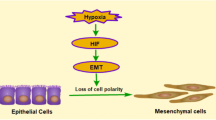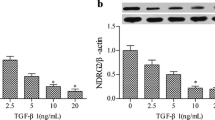Abstract
Hypoxia can cause Epithelial–mesenchymal transition (EMT) in renal tubular cells, and in turn, renal fibrosis. We tested the expression of TRIM46, a member of tripartite motif-containing (TRIM) family proteins, and mesenchymal markers under hypoxia. Our results showed that hypoxia significantly enhanced expression of TRIM46 in HK2 human renal proximal tubular epithelial cells. Our data further showed that hypoxia led to upregulated expression of mesenchymal markers including α-smooth muscle actin, vimentin, and Snail, and downregulated expression of epithelial marker E-cadherin, coupled with an increased abundance of nuclear β-catenin. However, such effects were reversed when TRIM46 expression was knocked down. TRIM46 overexpression had similar effects as hypoxia exposure, and such effects were reversed when cells were treated with XAV-939, a selective inhibitor for β-catenin. Furthermore, we found that TRIM46 promoted ubiquitination and proteasomal degradation of Axin1 protein, a robust negative regulator of Wnt/β-catenin signaling activity. Finally, increased TRIM46 coupled with decreased Axin1 was observed in a rat renal fibrosis model. These data suggest a novel mechanism contributing to EMT that mediates hypoxia-induced renal fibrosis. Our results suggest that selectively inhibiting this pathway that activates fibrosis in human kidney may lead to development of a novel therapeutic approach for managing this disease.





Similar content being viewed by others
Data availability
The datasets generated during the current study are available from the corresponding author on reasonable request.
References
Liu M, Ning X, Li R, Yang Z, Yang X, Sun S, Qian Q (2017) Signalling pathways involved in hypoxia-induced renal fibrosis. J Cell Mol Med 21:1248–1259. https://doi.org/10.1111/jcmm.13060
Nangaku M (2006) Chronic hypoxia and tubulointerstitial injury: a final common pathway to end-stage renal failure. J Am Soc Nephrol 17:17–25. https://doi.org/10.1681/ASN.2005070757
Tanaka T, Kato H, Kojima I, Ohse T, Son D, Tawakami T, Yatagawa T, Inagi R, Fujita T, Nangaku M (2006) Hypoxia and expression of hypoxia-inducible factor in the aging kidney. J Gerontol A 61:795–805. https://doi.org/10.1093/gerona/61.8.795
Tanaka T (2016) Expanding roles of the hypoxia-response network in chronic kidney disease. Clin Exp Nephrol 20:835–844. https://doi.org/10.1007/s10157-016-1241-4
Tanaka T, Nangaku M (2010) The role of hypoxia, increased oxygen consumption, and hypoxia-inducible factor-1 alpha in progression of chronic kidney disease. Curr Opin Nephrol Hypertens 19:43–50. https://doi.org/10.1097/MNH.0b013e3283328eed
Yang T, Chen M, Sun T (2013) Simvastatin attenuates TGF-beta1-induced Epithelial–mesenchymal transition in human alveolar epithelial cells. Cell Physiol Biochem 31:863–874. https://doi.org/10.1159/000350104
Zhao XL, Sun T, Che N, Sun D, Zhao N, Dong XY, Gu Q, Yao Z, Sun BC (2011) Promotion of hepatocellular carcinoma metastasis through matrix metalloproteinase activation by Epithelial–mesenchymal transition regulator twist1. J Cell Mol Med 15:691–700. https://doi.org/10.1111/j.1582-4934.2010.01052.x
Friedman SL, Sheppard D, Duffield JS, Violette S (2013) Therapy for fibrotic diseases: nearing the starting line. Sci Transl Med. https://doi.org/10.1126/scitranslmed.3004700
Liu Y (2011) Cellular and molecular mechanisms of renal fibrosis. Nat Rev Nephrol 7:684–696. https://doi.org/10.1038/nrneph.2011.149
Eddy AA (2014) Overview of the cellular and molecular basis of kidney fibrosis. Kidney Int Suppl 4:2–8. https://doi.org/10.1038/kisup.2014.2
Palm F, Nordquist L (2011) Renal tubulointerstitial hypoxia: cause and consequence of kidney dysfunction. Clin Exp Pharmacol Physiol 38:474–480. https://doi.org/10.1111/j.1440-1681.2011.05532.x
Zhu T, Yang J, Liu X, Zhang L, Zhang J, Wang Y, Ma H, Ren Z (2015) Hypoxiainducible Adrenomedullin ameliorates the epithelial-to-mesenchymal transition in human proximal tubular epithelial cells. Mol Med Rep 11:3760–3766. https://doi.org/10.3892/mmr.2015.3189
Wang Y, Shi J, Chai K, Ying X, Zhou BP (2013) The role of snail in EMT and Tumorigenesis. Curr Cancer Drug Targets 13:963–972. https://doi.org/10.2174/15680096113136660102
Zuo Y, Liu Y (2018) New insights into the role and mechanism of Wnt/β-catenin signalling in kidney fibrosis. Nephrology 23:38–43
Perugorria MJ, Olaizola P, Labiano I, Esparza-Baquer A, Marzioni M, Marin JJ, Bujanda L, Banales JM (2019) Wnt–β-catenin signalling in liver development, health and disease. Nat rev Gastroenterol hepatol 16:121–136
Huang P, Yan R, Zhang X, Wang L, Ke X, Qu Y (2019) Activating Wnt/β-catenin signaling pathway for disease therapy: challenges and opportunities. Pharmacol Ther 196:79–90
Feng S, Cai X, Li Y, Jian X, Zhang L, Li B (2019) Tripartite motif-containing 14 (TRIM14) promotes Epithelial–mesenchymal transition via ZEB2 in glioblastoma cells. J Exp Clin Cancer Res 38:57. https://doi.org/10.1186/s13046-019-1070-x
Di Rienzo M, Romagnoli A, Antonioli M, Piacentini M, Fimia GM (2020) TRIM proteins in autophagy: selective sensors in cell damage and innate immune responses. Cell Death Differ 27:887–902
Watanabe M, Hatakeyama S (2017) TRIM proteins and diseases. J Biochem 161:135–144. https://doi.org/10.1093/jb/mvw087
Hatakeyama S (2017) TRIM family proteins: roles in autophagy, immunity, and carcinogenesis. Trends Biochem Sci 42:297–311. https://doi.org/10.1016/j.tibs.2017.01.002
Lee HJ (2018) The role of tripartite motif family proteins in TGF-β signaling pathway and cancer. J Cancer Prev 23:162–169. https://doi.org/10.15430/jcp.2018.23.4.162
Yang YF, Zhang MF, Tian QH, Zhang CZ (2017) TRIM65 triggers β-catenin signaling via ubiquitylation of Axin1 to promote hepatocellular carcinoma. J Cell Sci 130:3108–3115. https://doi.org/10.1242/jcs.206623
Zhang L, Li X, Dong W, Sun C, Guo D, Zhang L (2016) Mmu-miR-1894-3p inhibits cell proliferation and migration of breast cancer cells by targeting Trim46. Int J Mol Sci. https://doi.org/10.3390/ijms17040609
Harterink M, Vocking K, Pan X, Soriano Jerez EM, Slenders L, Freal A, Tas RP, van de Wetering WJ, Timmer K, Motshagen J, van Beuningen SFB, Kapitein LC, Geerts WJC, Post JA, Hoogenraad CC (2019) TRIM46 organizes microtubule fasciculation in the axon initial segment. J Neurosci 39:4864–4873. https://doi.org/10.1523/JNEUROSCI.3105-18.2019
Uhlen M, Fagerberg L, Hallstrom BM, Lindskog C, Oksvold P, Mardinoglu A, Sivertsson A, Kampf C, Sjostedt E, Asplund A, Olsson I, Edlund K, Lundberg E, Navani S, Szigyarto CA, Odeberg J, Djureinovic D, Takanen JO, Hober S, Alm T, Edqvist PH, Berling H, Tegel H, Mulder J, Rockberg J, Nilsson P, Schwenk JM, Hamsten M, von Feilitzen K, Forsberg M, Persson L, Johansson F, Zwahlen M, von Heijne G, Nielsen J, Ponten F (2015) Proteomics tissue-based map of the human proteome. Science. https://doi.org/10.1126/science.1260419
Zaza G, Masola V, Granata S, Bellin G, Dalla Gassa A, Onisto M, Gambaro G, Lupo A (2015) Sulodexide alone or in combination with low doses of everolimus inhibits the hypoxia-mediated epithelial to mesenchymal transition in human renal proximal tubular cells. J Nephrol 28:431–440. https://doi.org/10.1007/s40620-015-0216-y
Zhao G, Tu L, Li X, Yang S, Chen C, Xu X, Wang P, Wang DW (2012) Delivery of AAV2-CYP2J2 protects remnant kidney in the 5/6-nephrectomized rat via inhibition of apoptosis and fibrosis. Hum Gene Ther 23:688–699. https://doi.org/10.1089/hum.2011.135
Tian XH, Hou WJ, Fang Y, Fan J, Tong H, Bai SL, Chen Q, Xu H, Li Y (2013) XAV939, a tankyrase 1 inhibitior, promotes cell apoptosis in neuroblastoma cell lines by inhibiting Wnt/beta-catenin signaling pathway. J Exp Clin Cancer Res 32:100. https://doi.org/10.1186/1756-9966-32-100
Hou Y, Ding M, Wang C, Yang X, Ye T, Yu H (2020) TRIM11 promotes lymphomas by activating the β-catenin signaling and axin1 ubiquitination degradation. Exp Cell Res 387:111750
Li Y, Xie P, Lu L, Wang J, Diao L, Liu Z, Guo F, He Y, Liu Y, Huang Q, Liang H, Li D, He F (2017) An integrated bioinformatics platform for investigating the human E3 ubiquitin ligase-substrate interaction network. Nat Commun 8:347. https://doi.org/10.1038/s41467-017-00299-9
Yoshida T, Shiraishi T, Nakata S, Horinaka M, Wakada M, Mizutani Y, Miki T, Sakai T (2005) Proteasome inhibitor MG132 induces death receptor 5 through CCAAT/enhancer-binding protein homologous protein. Cancer Res 65:5662–5667. https://doi.org/10.1158/0008-5472.CAN-05-0693
Nogueira A, Pires MJ, Oliveira PA (2017) Pathophysiological mechanisms of renal fibrosis: a review of animal models and therapeutic strategies. In Vivo 31:1–22. https://doi.org/10.21873/invivo.11019
Gobe GC, Coombes JS, Fassett RG, Endre ZH (2015) Biomarkers of drug-induced acute kidney injury in the adult. Expert Opin Drug Metab Toxicol 11:1683–1694. https://doi.org/10.1517/17425255.2015.1083011
Lokmic Z, Musyoka J, Hewitson TD, Darby IA (2012) Hypoxia and hypoxia signaling in tissue repair and fibrosis. Int Rev Cell Mol Biol 296:139–185. https://doi.org/10.1016/B978-0-12-394307-1.00003-5
Darby IA, Hewitson TD (2016) Hypoxia in tissue repair and fibrosis. Cell Tissue Res 365:553–562. https://doi.org/10.1007/s00441-016-2461-3
Kuo YL, Jou IM, Jeng SF, Chu CH, Huang JS, Hsu TI, Chang LR, Huang PW, Chen JA, Chou TM (2019) Hypoxia-induced Epithelial–mesenchymal transition and fibrosis for the development of breast capsular contracture. Sci Rep 9:10269. https://doi.org/10.1038/s41598-019-46439-7
Chilosi M, Poletti V, Zamo A, Lestani M, Montagna L, Piccoli P, Pedron S, Bertaso M, Scarpa A, Murer B, Cancellieri A, Maestro R, Semenzato G, Doglioni C (2003) Aberrant Wnt/beta-catenin pathway activation in idiopathic pulmonary fibrosis. Am J Pathol 162:1495–1502. https://doi.org/10.1016/s0002-9440(10)64282-4
Eberhart CG, Argani P (2001) Wnt signaling in human development: beta-catenin nuclear translocation in fetal lung, kidney, placenta, capillaries, adrenal, and cartilage. Pediatr Dev Pathol 4:351–357. https://doi.org/10.1007/s10024001-0037-y
Li Y, Xu S, Xu Q, Chen Y (2020) Clostridium difficile toxin B induces colonic inflammation through the TRIM46/DUSP1/MAPKs and NF-κB signalling pathway. Artif Cells, Nanomed, Biotechnol 48:452–462
Noutsou M, Duarte AM, Anvarian Z, Didenko T, Minde DP, Kuper I, de Ridder I, Oikonomou C, Friedler A, Boelens R, Rudiger SG, Maurice MM (2011) Critical scaffolding regions of the tumor suppressor axin1 are natively unfolded. J Mol Biol 405:773–786. https://doi.org/10.1016/j.jmb.2010.11.013
Mazzoni SM, Fearon ER (2014) AXIN1 and AXIN2 variants in gastrointestinal cancers. Cancer Lett 355:1–8. https://doi.org/10.1016/j.canlet.2014.09.018
Funding
This study was supported by Summit Discipline of Clinical Traditional Chinese Medicine in Pudong New Area of Shanghai (PDZY-2018-0601) and National Natural Science Foundation of China (82074261).
Author information
Authors and Affiliations
Contributions
JC and JL contributed to the study conception and design. Material preparation, data collection, and analysis were performed by LL, L D, YG, BZ, QX, CZ, WL, WL, ZL, and JH. The first draft of the manuscript was written by LL and all authors commented on previous versions of the manuscript. All authors read and approved the final manuscript.
Corresponding authors
Ethics declarations
Conflict of interest
The authors have no relevant financial or non-financial interests to disclose.
Ethical approval
This study was performed in line with the principles of the Declaration of Helsinki. Approval was granted by the Animal Care Committee of Seventh People’s Hospital of Shanghai University of Traditional Chinese Medicine.
Additional information
Publisher's Note
Springer Nature remains neutral with regard to jurisdictional claims in published maps and institutional affiliations.
Supplementary Information
Below is the link to the electronic supplementary material.
Rights and permissions
About this article
Cite this article
Liao, L., Duan, L., Guo, Y. et al. TRIM46 upregulates Wnt/β-catenin signaling by inhibiting Axin1 to mediate hypoxia-induced epithelial–mesenchymal transition in HK2 cells. Mol Cell Biochem 477, 2829–2839 (2022). https://doi.org/10.1007/s11010-022-04467-4
Received:
Accepted:
Published:
Issue Date:
DOI: https://doi.org/10.1007/s11010-022-04467-4




